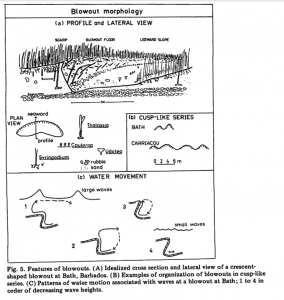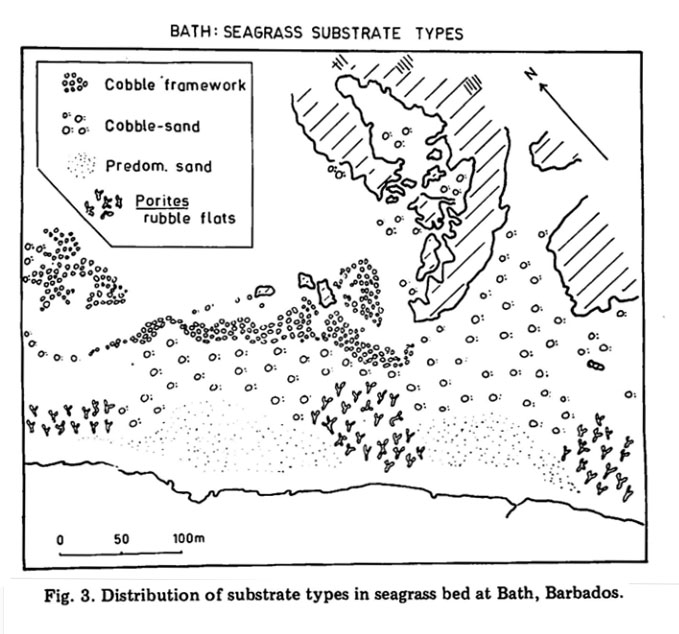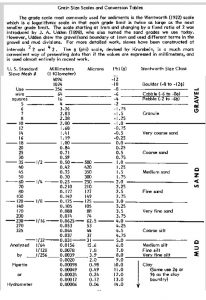From Patriquin 1975
Hydrography and substrates of the seagrass bed
Seagrasses at Bath, including Thalassia testudinum, Syringodium filiforme and Halodule sp., lie partially in the lee of algal- and coral-encrusted rocks lying about 300 m offshore (Fig. 2).
The seagrass bed has a complex topography and distribution of sediments as a result of the irregular topography of the bedrock, the complex wave regime, and prolific biogenic production of sediment of clay to cobble size. Mean tidal range is approx.O.7 m, and the diurnal range, 1.1 m (Lewis, 1960). The seagrass bed is shallow, and conditions are generally turbulent except for a few hours at low water. There are weak (0-21 cmlsec) currents associated with an overall northwesterly flow of water across the bed.
In regions of strong seaward return flow of water (Fig. 2), currents reach speeds of 45 em/sec and greater. Waves over the seagrass bed are generally of the order of 30-60 em height at high water, and break over the entire seagrass bed area. During winter months when the east coast of Barbados is frequently subject to large swells (Dorm and McGuinness, 1959), waves over the seagrass bed may reach heights of 1 m and greater, and longshore currents may reach speeds in excess of 60 em/sec.
The seagrass bed sediments are predominantly (> 75%) of local biogenic origin, and generally contain less than 10% fines (sizes less than 62 microns). Halimeda, corals (chiefly Porites furcata) articulated red algae, forams (Homotrema, Rotalia and others) and gastropods are the main contributors to the sand-sized carbonate fraction. Four substrate types are distinguished on the basis of the quantity and nature of pebble- and cobble-sized material (Fig. 3):
(1) Thalassia-colonized “cobble framework” substrates occur at the seaward face of the seagrass bed where accumulations of rhodiles (Bosellini and Ginsburg, 1972; Ginsburg and Bosellini, 1973) and coral debris originating from the hard bottom seaward rise to within 25 cm of the water surface and occupy over 70% of the sediment volume (Fig. 4).
(2) Thalassia- and Syringodiurn-colonized “cobble-sand” substrates in which pebbles and cobbles are up to one-half of the substrate volume, occur over most of the seagrass bed.
(3) “Porites rubble flats” occur in several nearshore areas where accumulations of stick-like skeletons of the coral Porites furcata originating from the cobblesand substrates fonn a platform which is largely exposed at low water of spring tides. The Porites skeletons occupy about 50% of the sediment volume. Most of the Porites rubble flats are colonized by Thalassia, but in a few areas, mounds of Halodule and sand forming over the rubble substrate rise to about mean low water level. In more wave exposed areas the Porites rubble flats have become overgrown by sponges and coralline algae, and Thalassia excluded.
(4) Syringodium- and Thalassia-colonized “predominantly sand” substrates in which pebbles and cobbles are less than 5% of the substrate volume, occur inshore between the Porites rubble flats.
———-
Size categories.
The system in common use at the time was the Wentworth Scale as described by Folk 1965.
Folk, R.L. 1965. Petrology of sedimentary rocks, 159 p.Hemphilp, Austin, Texas 1 PDF
One this scale,
Cobbles are 64 to 256 mm (-6 to -8 phi)
Pebbles are 4 to 64 mm (-2 to -6 phi)
granules are 2 to 4 mm (-1 to -2 phi)
sand 0.0625 to 2mm (4 to -1 phi with 5 subcategories of sand
Silt 0.0039 to 0.0625 mm (8 to 4 phi)
Clay <0.0039 mm (>8 phi)
View Patriquin (1971) p 168 for details of how grain size distributions were determined.
Blowouts
 “Migration” of blowouts in seagrass beds at Barbados and Carriacou, West Indies, and its ecological and geological implications
“Migration” of blowouts in seagrass beds at Barbados and Carriacou, West Indies, and its ecological and geological implications
DG Patriquin, 1975 Aquatic Botany Volume 1, Pages 163-189. View PDF Abstract:
“Blowouts are grass-free depressions within seagrass beds at Barbados and Carriacou and reported in the literature to be common elsewhere in the Caribbean region. They are typically crescent-shaped in plan view with the convex side seaward, and are characteristic of elevated seagrass beds in regions of moderate to strong wave action. The seaward edge is steep and exposes rhizomes of Thalassia while the leeward edge slopes gently upward onto the seagrass plateau and is usually colonized by Syringodium. The general morphology of the blowouts, the zonation of organisms across them, and the existence at some blowouts of a lag deposit of cobble-sized material at the scarp base continuous with a rubble layer below the seagrass carpet suggested the blowouts “migrate” seaward. Measurements of erosion at the scarp and of advance of Syringodium onto the blowout floor over a period of one year confirmed this. It is estimated that in the region of blowouts any one point will be recurrently eroded and restabilized at intervals of the order of 5–15 years. Such processes limit successional development of the seagrass beds, disrupt sedimentary structures, and may result in deposits much coarser than those characteristic of the sandy seagrass carpet.”




